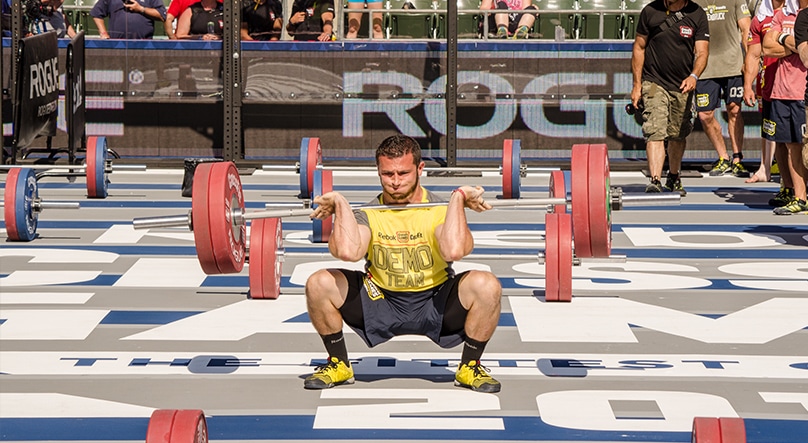Jump to:
First thing’s first—what is the hole?
The ‘hole’, as is known in weightlifting, power lifting, and Olympic lifting circles, is the lowest part of a squat— usually the receiving position for the clean and the snatch. How you handle the hole play a large part in determining your success as a squatter—not to mention how far you can progress in the Olympic lifts.
When we lift a weight we know we can handle, we know that we can lower the bar into the bottom position of the squat (or drop under it in the clean/snatch), and stand up with it again. We may struggle and have some sticky points in those lifts, but we know we can stand the weight up—simply because we’ve done it before. But getting out of the hole takes on crucial importance when we start to tackle those heavier weights. Your chest caves, elbows drop, legs shake and your knees bend in and out like a flag in the wind. You may be able to stand the weight up, but you do so slowly and without power. Of course, when you’re fighting for a PR, it’s hard to stop those things from happening. You just want to get the bar up, no matter how ugly it looks—trust me, I’ve been there. You might even manage to complete the lift, too—but you probably moved out of the hole slowly, and without as much explosive power as you know you’re capable of.
Being able to explode out of the hole helps to carry you through the sticky points of any lift—where that fight-or-flight syndrome kicks in. If you’re moving with power out of the bottom position (as well as with good form, as I’ll touch on), then it becomes that much easier to ‘fight’ through the difficult portions of the lift to complete the rep. And with specific regards to the clean and jerk, driving with power out of the hole allows you to ‘pop’ the bar off your shoulders when you come out of the clean so that you can reposition your hands in preparation for the jerk.
So now the question becomes, how do you develop power out of the hole?
Work on mobility
To be in ‘the hole’, one must first reach the bottom position of the lift. If you can’t hit full depth with just the bar (or if it’s a mighty struggle to get there), then you need to go right back to the drawing board and start working on your flexibility. That means working on opening up your hips, working on ankle mobility, wrist and shoulder mobility for the front rack (and overhead) squat. There’s a reason that Olympic Weightlifters are some of the most flexible athletes in the world. They have to move a gargantuan amount of weight, so they need to put themselves in the best physical position to receive the bar (and all that weight). To do that, they need to be as flexible as possible in multiple areas. Furthermore, if you can put yourself in a good position to receive and move the bar, then you’ll have an easier time executing the right technique when it comes to getting out of the hole. Speaking of which…
Work on form
This is of particular importance when it comes to the clean and the snatch. Of course it’s important to execute proper form on all squatting variations (the overhead squat is tricky for many—click here for tips on how to get better at them), but the Olympic lifts are far more complex in their design. As I’ve mentioned, a crucial aspect of getting out of the hole lies in putting yourself in the right position to do be able to do so. If you’re receiving the bar with your elbows down (in the clean), chest too far forward, on your tip toes, then how successful are you going to be when it comes to trying to stand that weight up? Foot position, hand position, elbow position—there’s a long checklist of things that you need to work on in order to develop good form and, as a result, put yourself in the best possible body position to move the weight and yourself out of the hole. A great way to develop good form is to work on accessory lifts.
Accessory work
Also known as complimentary exercises, accessory work entails all the drills and variations of traditional lifts. These exercises are designed to strengthen specific muscles and portions of your traditional lifts. For example, the Sots press is a mobility and strength exercise that is designed to improve an athlete’s receiving positions for the clean and the snatch. Here are two of the best accessory drills that you can work on to help build that explosive power out of the hole.
Pause Squats
During a pause squat, an athlete comes to complete stop at the bottom of the movement, holds the position for however long is dictated, then explodes out of the hole. This is quite literally how you perform the movement. You would perform whatever type of squat (overhead, front, back) as you normally would, keeping good form throughout knowing that you must come to a complete stop at the bottom position, below parallel. At this point you can play around with the time you hold the weight, from 1,3,5 or even 10 seconds, but it is important that you use a lighter weight than you normally would for that squat as it’s much harder to come out of the hole from a stationary position than it is from one fluid motion. But that’s the point.
Stopping the squat at the bottom significantly reduces the amount of stress placed on the lower back, but causes the legs to have to work much harder to push back to the starting position. This is because a pause gives the legs greater time under tension, and increases muscular recruitment. As the fast twitch fibers continue to fatigue during the pause, slow twitch fibers (and muscles) are recruited in order to help stabilize the body in that position. The more you perform pause squats, the more the body and brain gets used to recruiting slow twitch muscle fibers and builds the strength of the supporting muscles in the lower back, hips and abs, which bodes well for your overall squat numbers and strength in other movements.
Furthermore, pause squats force you to hold a deep, uncomfortable position in the hole for an extended period of time, which is something that we aren’t really used to. But if we do pause squats enough and become comfortable holding heavy weight in that position, it’s going to make it that much easier to drop down and drive up with power when we know there is no pause involved.
Dead Squats
Dead squats are a squat variation in which you only perform the concentric portion of the lift (the shortening of a muscle as it acts against resistive force—i.e. the upwards phase of a back squat). Dead squats build starting strength, acceleration strength, limit strength, explosive strength, relative strength and rate of force development.
Performing the dead squat:
- Set the bar in a low position in the squat rack, so when you move under the bar you are already starting at below parallel—i.e., you’re already in the hole.
- Assume the proper squat stance, taking care to make sure your feet are positioned well, abs and butt are tight, and your hand position is good.
- Stand the weight up explosively.
- It helps to have a squat rack with two sets of pins (one below parallel, one at shoulder height) so that when you complete the dead squat you can simply walk the bar back in the rack. Of course, if you want to do multiple sets of the movement, you could bring the bar back down to the low pins and step away from the rack.
- Here’s a video demo.
Practice compensatory acceleration training
One of the things you can start doing right now when you perform any weightlifting movement (not just squats) is work on your compensatory acceleration training (CAT). CAT is a training methodology in which an athlete deliberately tries to accelerate the bar throughout the concentric phase of the instead of applying less force to a lift because the load is lighter. CAT methodology requires an athlete to execute maximum force on a lift, regardless of the weight. Now, when we are lifting lighter loads for reps (or whatever situation), some athletes have a tendency to move through the reps slowly and under control. There’s nothing wrong with that, but if you want to be able to develop power and force out of the whole, you have to speed things up. Why? Because force: mass x acceleration. So when the mass (the weight) is low, you have to make up for it with increased speed to generate a good amount of force.
Lifting a lighter weight with maximal speed will provide many of the strength training adaptations of lifting heavier weight. In addition, lifting a heavy weight with the intent to move it as quickly as possible provides explosive strength benefits. Training like this will force your body and your central nervous system (responsible for processing information received from all parts of the body) to adapt in a positive manner to the demands you place on it by moving the weight as quickly as possible.
Pictured: Austin Malleolo at the 2014 CrossFit Games
















